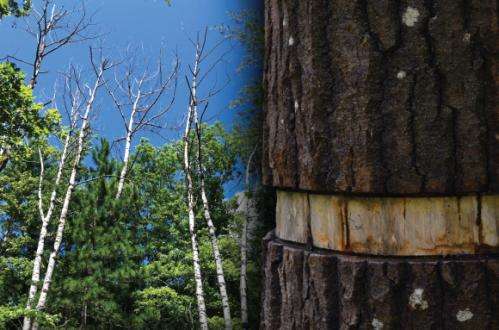PNNL researchers and colleagues tested a variety of forest models against real-world data from an experimental forest in Michigan where trees were "girdled" to make them die. They found that current models don’t take into account the way today’s forests are aging.
Trees are dying at increasing rates across much of the U.S., surprising forest managers and climate scientists alike. After all, the memories of early 20th century land clearing and logging are fading from today's forests. Now, new research at Pacific Northwest National Laboratory shows that the problem in predicting how forests age may lie in the forest models, not the trees. As reported in Biogeosciences, the research team found that trees may be dying from old age, but in general, forests are much more resilient than originally thought.
"This research highlights weaknesses in the current generation of forest models," said Dr. Ben Bond-Lamberty, an environmental scientist at PNNL who teamed with colleagues at Lawrence Berkeley National Laboratory and the University of Maryland on the work.
Forest managers, climate scientists, and policy makers all need comprehensive and accurate models of how forests respond to disturbances, aging, and death. Existing forest models usually focus on catastrophic disturbances like wildfires and massive harvesting. Until now, researchers simply were not sure whether these models can robustly simulate moderate, or non-catastrophic, disturbances such as wind and blight. What they found is that these events, increasingly common in aging U.S. forests, tend to increase the forest's biological and structural complexity, which is why current models may be stymied to simulate them accurately.
"The results point the way to future improvements that will let us more confidently predict how aging forests will respond to climate change and other disturbances," said Bond-Lamberty. "This is particularly important as the current generation of trees in U.S. forests dies off over the next 20 years."
Scientists started with data gathered during the Forest Accelerated Succession Experiment (FASET) in northern Michigan between 2008 and 2012. Under FASET, thousands of trees were girdled-killed in a manner that would simulate a change in the species of a forest.
Using a common modeling approach, a scientist from each of the three institutions input FASET data into one of three fundamentally different forest models to see how well those models could replicate FASET's results. This test was unique, given the diversity of models involved and unusual nature of FASET. The scientists found that none of the models fully matched the real-world results, though one predicted resilience correctly, if for the wrong reasons.
The scientists plan to look at how ecological mechanisms support forest resilience to disturbance and whether these mechanisms are included in current forest models. They will also examine the potential consequences of forest resilience over longer timeframes and larger areas.
More information: Bond-Lamberty B, JP Fisk, JA Holm, V Bailey, G Bohrer, and CM Gough. 2015. "Moderate Forest Disturbance as a Stringent Test for Gap and Big-Leaf Models." Biogeosciences 12: 513-526. DOI: 10.5194/bg-12-513-2015
Journal information: Biogeosciences
Provided by Pacific Northwest National Laboratory




















